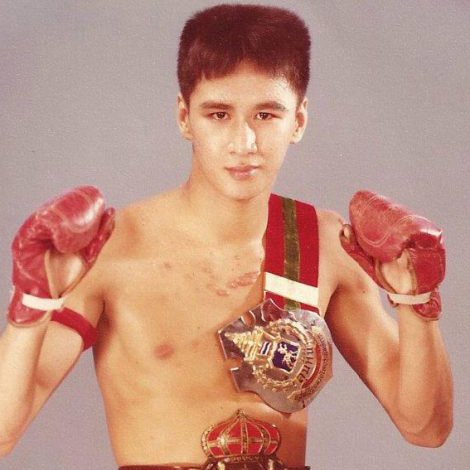Search the Community
Showing results for tags 'muay thai library'.
-
Kali (Pekiti Tirsia to be more specific) is the only other martial art I have practiced for a significant time (about 8 years or so). It's a Filipino art that is not very "sportified" and is based on the use of blades and impact weapons (empty hands training is done, too though but its based on the same patterns and concepts as the blades). I found it really interesting how similarities between different arts pop up, especially with the more traditional styles. There is so much that sounded very much familiar to me in the Muay Lertrit sessions. Things that are either very much the same as I learned in Kali or at least follow the same principle. There is this thing about "let them try to strike you but make them pay every time" that we also did a lot. Directly counterattacking instead of blocking is a central concept there. Stuff like parrying a punch with a move that, if done well, is supposed to strike the opponent in the same move as it parries their punch. Or making someone who uses a leg kick on you pay by not only blocking with your own shin but dropping your knee on their ankle while doing so, very similarly to what the general demonstrates in that one session. Also I've watched the session with Gen Hongthonglek a few times and only the last time it suddenly occurred to me that the way he uses fakes, delayed timing and counters is actually very similar to how I used to do sparring with the stick in Kali when I was more experienced. I'd typically move back to keep range (I'm a very tall guy with long arms) and would constantly weave my stick in front of me or throw my opponent off with some weird position kind of like Gen does with his feet before he lands his big kicks. This kinda stuff is really fascinating to me. Sure there are differences between arts but often there are also overlaps or concepts that can be applied to other arts as well. Did you have similar experiences? PS: Of course there are differences, too: For example Kali teaches you to give not getting hit (at all if possible) top priority because an opponent could always carry a weapon even if you don't see it right away so every hit might be very dangerous. Thats something I have to practice to overcome a bit in Muay Thai where the opponent is guaranteed to not have a weapon and getting hit is not actually a mistake in principle.
- 13 replies
-
- 7
-

-

-

-
- technique
- muay thai library
-
(and 1 more)
Tagged with:
-
We were talking to Chatchai Sasakul, a fighter who fought so many of the greats in the Golden Age in Muay Thai, and then came into fame winning the WBC World Championship western boxing belt. He's in the Library here, and we are about to add another session with him. We were asking him why in his fight style back in the day he wasn't doing many of the things that he was advocating now. He said, "back then I didn't know". He looked at us like we were crazy, like "what do you think I've been doing for 20 years since I retired" or "of course I didn't know, I was young". It brought home for me one of the most special things about the Library. We talk about it as if it is preserving the literal techniques of the Golden Age, but it is much more than that. It's preserving those techniques AS they have undergone a period of reflection and refinement. If you talked to an active fighter you may very well get some very noteworthy pointers on how to fight. But if you talk to that fighter 15 or 20 years later you get something very different. You get those elements having passed through a very long stage of reflection. You get to see those elements, very often, taken up as craft. Sometimes, if that fighter has fallen out from the fight game entirely, like maybe someone like Samson Isaan (in the Library here), and who is a taxi driver, this is mostly the craft of recollection, of memory. What he knows and thinks about are all the things that worked for him, and probably some of the things that didn't work for him, things that had success against him. The whole thing goes into a process of memory's slow boil, low and slow, and what you get is a condensed essence of fight knowledge, his style, under refinement. Even if he isn't actively working on improving on or conveying his fighting style, it has been worked on by memory and reflection. It is the art of his style, his knowledge. On the other hand when you have someone like Sagat - you can find him in the Library here - this is someone who has been teaching Muay Thai for probably three decades. Not only is he bringing his fight style, the one he once had, but he has become a craftman about it. What he is teaching is a rarified, purified form of his fighting style, something that has been honed and polished over decades of communication and thought. What he is showing you in the ring today is very different than what he would have showed you 30 years ago. It is enhanced, has been worked on endlessly. Not in the "I've got to be a better teacher" way, but rather that each time you try to convey something you touch it a little, you change it, you add reflection on it. Sagat teaches a great deal of precision and correction on his strikes, as does Chatchai, who also has been teaching for years. Chatchai as a fighter would drift away on his jab. Today he insists, do not do this, this is stupid. I've seen Sagat incorporate things into his teaching that I know he recently has experienced - for instance he has been helping General Tunwakom teach Muay Lertrit lately. These internal elbows are now in his mind, as he teaches movements. Sagat is 60 years old, and his Muay is still evolving. I've watch Karuhat come up with brilliant throws, things he is simply inventing on the spot, feeling his way on, things I've never seen before, because Karuhat when he was a fighter in his gym would always be experimenting, stealing things from others, dreaming up new wrinkles. When we look back in time, through our telescope of the Library it isn't like how starlight is reaching us from far away, how it was years ago. It's instead coming to us with immediacy, having passed through the reflections of these men, as they have become craftsmen, working on the raw materials of their fight days, lifting it to art. Perhaps nobody is more like this than Master K, Sylvie's first instructor back in America. He's 80 years old now, and his Muay Thai is this incredible time capsule of Muay Thai before the Golden Age, the Muay Thai of the late 1960s 1970s. But...it also is filtered and hand sanded by the mind of a Thai man who was no longer in Thailand, reflected on, improved and dreamed up through watching the great boxers of the decades, long ruminations in his own basement kicking the bag until 2 AM, the result of a craft-work of elaboration and self-creation. I think that is what a lot of us miss. These men, all of these men, are producing the work of their mind, as artists, as creators, bringing to life and carrying forward a new thing. It isn't just their techniques, or even their fighting styles. It's the fecundity of the years since they stopped fighting. It is their meditation. What is also kind of incredible is that these ruminations, these craft-works, have been documented and continue to be documented. And that Sylvie has first hand seen them. You can see the full library here.
- 4 replies
-
- 7
-
-

-
-
- patreon
- muay thai library
-
(and 1 more)
Tagged with:
Footer title
This content can be configured within your theme settings in your ACP. You can add any HTML including images, paragraphs and lists.
Footer title
This content can be configured within your theme settings in your ACP. You can add any HTML including images, paragraphs and lists.
Footer title
This content can be configured within your theme settings in your ACP. You can add any HTML including images, paragraphs and lists.



